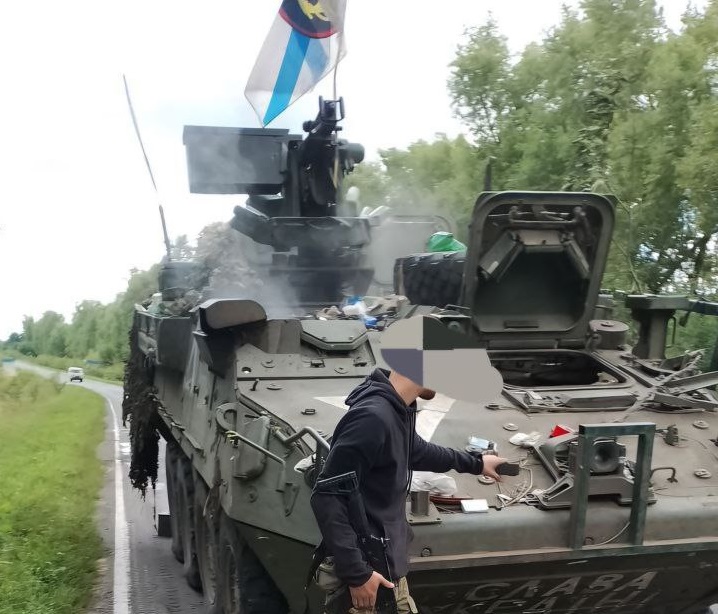As the Kursk invasion progresses, the Armed Forces of Ukraine (AFU) face shelling of their convoys, risking repeating the mistake of Russian forces made at the beginning of the war in 2022. Meanwhile, Ukrainian defences in the Donbas are gradually weakening amid an offensive in another region.
Russian media publish footage of destroying scarce Ukrainian vehicles in the Kursk region, Russia. A vivid example of careless manoeuvring is the demolition of a column of Ukrainian equipment by the Russian 810th Guards Naval Infantry Brigade:
According to the footage, the vehicles that came under fire attempted to leave the ambush site at high speed, but some of the vehicles were destroyed, while others were damaged or abandoned by the retreating Ukrainian soldiers.
Media also released materials showing an ambush by Russian troops on a mobile group of the 82nd Separate Air Assault Brigade of the AFU.
Here we have a visit from the 82nd Separate Air Assault Brigade. Fearless and loyal. This is what happened to them.

Meanwhile, a Marine from the 810th Brigade shared a video of them hijacking a US Hummer military vehicle.
Greetings! We are from Russia. Black Sea Fleet, the 810th [Brigade], motherf****r! (…) I don’t know, can you see me, no? Can you f***ing hear me? But we’ve just nicked a Hummer from these f***ers!

The AFU’s rapid offensive is complicated by the fact that some of the artillery involved in the operation is forced to hide somewhere on the territory of the Sumy region, Ukraine. However, in order for the ground forces to advance, the artillery has to follow their troops, which in conditions of fire superiority and Russian air supremacy can lead to heavy losses.
For example, Russian and Ukrainian media publish footage of the destruction of the scarce HIMARS multiple launch rocket system near the village of Mohrytsya in the Sumy region, about 18 kilometres from the town of Sudzha.
In addition to a large number of brigades for deep breakthroughs, elite AFU units, including the 82nd and 95th Separate Air Assault Brigades, have been involved in the attack since the first days. Commander-in-Chief of the AFU, Oleksandr Syrskyi, and the alleged coordinators of the incursion have opted for high-speed raids and rapid establishment of control over captured territories, which requires high mobility and training.
Protracted offensive
However, the longer a military operation lasts, the more often troops must linger while waiting for assistance, evacuation, or reserves to carry on the offensive. For groups engaged in a blitz offensive, stalling in one place means sure death in almost every case. Russian media publish a Polish PT-91 Twardy main battle tank and a T-72AV from the AFU’s 22nd Mechanised Brigade destroyed by Lancet drones in the Kursk region.
Under such conditions, any assault troops turn into ordinary infantry, like those that have been fighting on other front lines since the beginning of the war. In Donbas (the common name for Luhansk and Donetsk regions), Ukrainian forces are facing weakened defensive positions as commanders shift some troops to assault in the Kursk region. If Russia seizes the opportunity to dislodge the slowing AFU troops, this could deal a serious blow to the motivation of Ukrainian soldiers, military experts say.
Russian media also shared footage of destroying AFU combat vehicles from a Russian helicopter:
Meanwhile, Ukraine’s offensive into Russia has spread to the Belgorod region, where fierce fighting is taking place, according to The Washington Post. New details about the battles in Belgorod, described by Ukrainian soldiers wounded there who were evacuated across the border to Ukraine’s Sumy region, emerged after Ukraine appointed a military commander to manage its captured areas of the Kursk region on Thursday.
However, in contrast to the exultation of some who fought in Kursk, the fighting in Belgorod was especially ferocious. This occurred because Russian troops in Belgorod were put on high alert against the backdrop of the Kursk incursion. That may have contributed to the tougher resistance, Brady Africk, an open-source analyst and senior media associate at the American Enterprise Institute, suggested.
Russia responds, US does not
Russian Defence Minister Andrey Belousov outlined an action plan to protect border regions. He held a regular meeting dedicated to security in the Kursk, Bryansk, and Belgorod regions.
The meeting focused on additional measures to protect the population and infrastructure in the affected territories. The General Staff also presented an action plan concerning the strengthening of troop management, coordination with other agencies and allocation of additional resources.
Belgorod Region Governor Vyacheslav Gladkov and other high-ranking officials also attended the meeting, according to Russian media.
Meanwhile, US Defence Department spokeswoman Sabrina Singh told a Press Briefing on 15 August that Washington did not consider Kyiv’s decision to avoid informing the United States about the offensive to be a failure of US intelligence. Singh also stated that she did not see it as a sign of mistrust on the part of Kyiv.
There is deep trust there, and there has to be deep trust. We’re on our 61st, 62nd presidential drawdown package. We are pouring millions upon billions of dollars into Ukraine to make sure that they have what they need on the battlefield. We are assisting them with their capabilities. We’re training their pilots.
By stalling operations in the Kursk region, Ukraine risks repeating the mistake made by Russian forces in 2022, when an insufficiently rapid offensive led to troops being forced to withdraw to earlier positions.
